Amid a flood of emails, social media posts, and online advertisements, modern marketers are looking for a fresh approach to cut through the digital clutter and capture the attention of their target audiences. But what if, rather than grasping at the next big thing, there was a tried and tested way to reach your recipients?
Forming a tangible and personal connection between businesses and their potential customers, direct mail’s enduring relevance might come as a surprise to some. But even in a world dominated by digital marketing, research shows that direct mail provides the highest ROI of all media. That’s right – higher returns compared to paid media, content marketing, social ads & TV!
Nevertheless, when it comes to your next direct mail campaign, simply posting an ill-thought-out flyer through a letterbox won’t cut it. Not only is creativity key, but technology isn’t the enemy of direct mail marketing. Instead, the digital landscape has provided new ways to revitalise this age-old marketing technique.
Creative direct mail ideas to help retain and acquire customers for your business
Postcards
Despite their seemingly traditional nature, postcards are a potent tool in the direct mail armoury. Moreover, integrating creativity, data, and digital technologies into your postcard campaigns can increase engagement, infuse personalisation, and drive conversions. Together, this leads to more successful and impactful mailers.
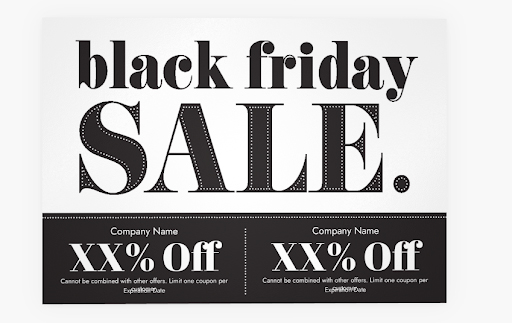
An example of a postcard template by VistaPrint. Source: VistaPrint
Compact, simple, and attention-grabbing, here are some examples of how businesses can use postcards in their direct mail campaigns:
- Retailers could use data about buying habits to send postcards to customers who have shown an interest in related products.
- Hairdressers could include a link to an interactive App that lets recipients upload an image of themselves and experiment with new hairstyles.
- Restaurants could use postcards to encourage recipients to engage with their brand on social media, with hashtags and calls to share user-generated content, and prizes for doing so.
- A new bakery could send a postcard to local residents to inform them about their opening and offer a royalty programme for repeat customers.
- Nightclubs could use postcards to promote an upcoming event, directing recipients to a landing page where they can RSVP and access exclusive content.
Coupons
Coupons have long been recognised as a powerful marketing tool. And, while they are one of the most conventional promotional methods available, when combined with digital technologies, businesses can create dynamic and data-driven direct coupon campaigns that maximise ROI.

An example of a coupon template by VisMe. Source: Visme
Offering enticing incentives to potential buyers and fostering brand loyalty in repeat customers, here are just some ways businesses can use coupons to enhance the effectiveness of their direct mailers:
- Businesses could add a QR code on their direct mailers that, once scanned, gives recipients access to exclusive coupons, offers and discounts. As well as the ability to use these coupons online, they could also be scannable and redeemable in-store.
- Supermarkets could add location-based codes to their coupons to determine which areas have the highest redemption rates and for what products. The stores could then use this data to support future marketing efforts.
- A beauty salon could include free samples, offers, coupons, and vouchers to encourage potential customers to try a product.
- A business could send existing customers a discount coupon on their birthday, making them feel valued and encouraging repeat business.
When launching the Kit Kat Chunky, Nestlé sent out a personalised “we’re sorry we couldn’t deliver your parcel” card, that invited customers to redeem their treat from a local newsagent. The message being that it was just too chunky to fit though the letterbox!
Catalogues
Presenting a tangible and thorough way to showcase products or services, catalogues are another valuable asset in the marketer’s toolkit.

An example of a catalogue template by Canva. Source: Canva
With a format that best suits businesses that want to provide more comprehensive information to their target customers, here are some ways to use catalogues effectively in direct mail campaigns:
- Furniture stores could integrate AR technology to help potential customers visualise products in a real-world setting. Customers could scan product QR codes in the catalogue to access this interactive functionality.
- Stores could add unique URLs next to each product, directing customers online for a quick and convenient purchase. Tracking analytics could also be used to monitor the online activity of recipients and customise promotions accordingly.
- A bookstore could encourage recipients to share their favourite/ sought-after new releases from a seasonal catalogue on social media using a dedicated hashtag, thus creating a buzz around their latest offerings.
Gifts & Free Samples
The allure of free samples never goes out of fashion. And, enticing customers to experience a product firsthand, adding these to your direct mail campaigns can make a powerful and lasting impression.
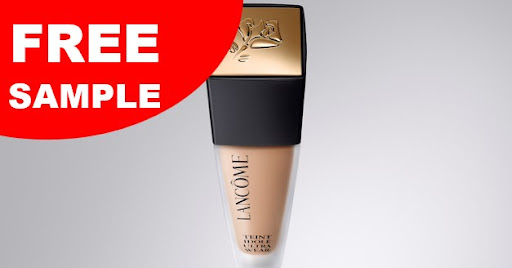
An example of a catalogue template by Lancome. Source: Freeflys
Moreover, when you fuse free samples with creativity and/or modern digital technology, you can create more interactive experiences for recipients. This leads to increased brand exposure, better customer engagement, and higher conversion rates. For example:
- Encouraging immediate engagement, a cosmetics company could use QR codes in their direct mail piece, prompting recipients to scan and request a free sample of their latest skincare product in return for their email address. Then, knowing what products each potential customer is interested in, the business could use this data to inform future marketing campaigns.
- A games company could include details of a new app that leads recipients to a gamified portal where they can play and win for free before signing up.
- A pet food company could send a free sample of their new dog snacks and invite recipients to post a photo with the sample on Instagram (tagging the company and using a specific hashtag).
- A new coffee shop could send free samples of their products to people in the local area, generating buzz before opening.
Leaflets & Flyers
A firm favourite due to their cost-effectiveness and simplicity, leaflets and flyers punch well above their weight when it comes to results. Indeed, while digital tools might have transformed the marketing landscape over the last few decades, the undeniable power of traditional printed marketing materials like leaflets and flyers remains steadfast.
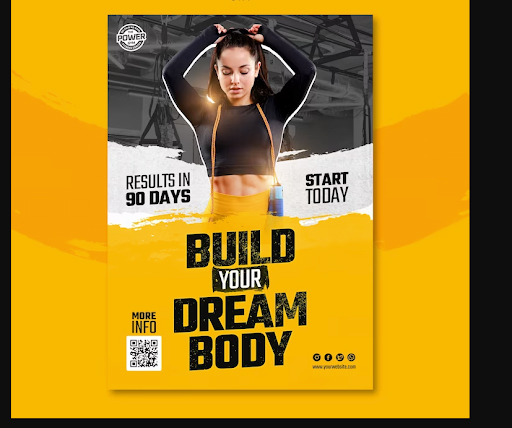
An example of a leaflet design template by Freepik. Source: Freepik
Through clever data integration, personalisation, design and strategic targeting, direct mail flyers will resonate more deeply and effectively with their intended audience. For example:
- A restaurant could include a QR code or URL on its flyer that leads to an online menu, allowing recipients to explore its offerings and make reservations.
- An event organiser could include a scratch-off section on a flyer revealing a discount code for ticket purchases/free tickets. Such elements encourage recipients to interact with the flyer and make it more memorable.
- A local gym could include social media icons on their flyer, inviting recipients to share their fitness goals and journey using a specific hashtag.
Letters
Letters offer a unique opportunity for businesses to establish an emotional connection with their audiences, conveying their messages thoughtfully and directly. Indeed, despite our digital age, the personal touch and sincerity of a well-crafted letter have stood the test of time.
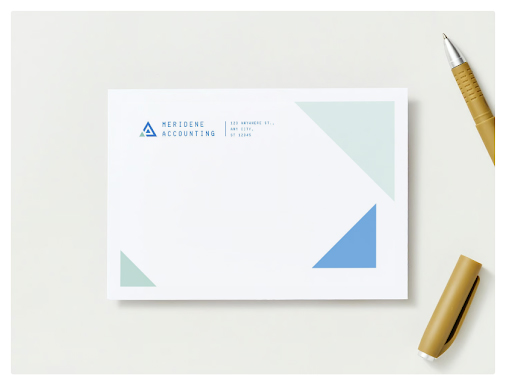
An example of an envelope design by Canva. Source: Canva
This marriage of old-school authenticity and innovation can breathe new life into direct mail campaigns, making them even more impactful and engaging in today’s competitive marketing landscape. For example:
- A University could send a letter to prospective students and follow this up with a series of personalised emails to boost brand awareness.
- An insurance company could include a QR code in a letter that leads recipients to a webpage where they can calculate potential policy savings.
- A charity could include a tear-off donation card in a letter, allowing recipients to contribute easily.
Best practices for your direct mail campaign
There are several vital elements to a lucrative marketing campaign; miss just one, and you could be in trouble. As such, if you want your direct mail campaigns to do well, you must do more than pop a leaflet through a letterbox. An effective direct mail campaign must be well crafted, engaging, and drive desired actions.
Helping to ensure your efforts are focused, targeted, and aligned with your overall business objectives, here are some essential best practices to help you succeed:
1. Make it personal
Personalised, tailored messaging always works best when running a direct mail campaign. According to one study:
- 78% of consumers are more likely to make repeat purchases from brands that personalise their advertising
- 71% of consumers expect companies to deliver personal interactions
- 76% get frustrated when this doesn’t happen.

An example of a personalised handwritten letter design by Lettrlabs. Source: Lettrlabs
Addressing recipients by their names can improve engagement and response rates. But personalisation should go further than that. A comprehensive understanding of your target audience will empower you to tailor your content, design, and offer to resonate with your audience. And doing this will boost the success of your marketing campaigns.
Of course, any direct marketing campaigns should also be compliant with the latest data protection laws! If you are concerned about GDPR, you can still create an effective leaflet distribution campaign without relying on an individual’s information. For example, by strategically targeting specific postcodes where you know that your audience resides, you can run a personal campaign, without worrying about data protection breaches.
2. Create/update your mailing list
When it comes to direct mail marketing, your mailing list is one of your most important assets. Ensuring that your advertising reaches those individuals or businesses most likely to be interested in your products or services, the better your data, the more positive the response is liable to be.
Whether you are using your own data or purchasing it from a mailing list provider, it is essential that you check, refine, and update it before every direct mail campaign.
3. Stand out with an eye-catching design
Savvy designers often use vibrant colours to engage recipients and encourage them to read and respond to marketing messages. So, consider using bold colours to capture attention and enhance the visual appeal of your direct mailers.
That being said, you should ensure that any marketing material you send does not undermine your brand identity. So, if bold colours are not your thing, don’t use them just for the sake of it.
Good design is essential if you want your direct mail campaign to capture attention, make a
positive brand impression, and reflect your business’s credibility. So, colourful or not, create an attention-grabbing layout with clearly conveyed messages to drive engagement and response rates.
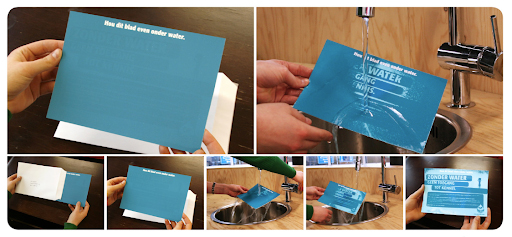
A Belgian corporation sent out a card to highlight the importance of World Water Day. However, the mailer only revealed its content once held underwater. Source: Direct Daily
4. Use high-quality printing
Poor-quality printing can significantly limit the success and effectiveness of your direct mail campaigns. On the other hand, a well-printed direct mail will give a positive first impression and convey a sense of professionalism.
Quality printing will also ensure your message is clear, legible, and easy to read. And, of course, in a crowded mailbox, a well-printed direct mail will stand out and increase the likelihood that the correspondence will be retained or shared.

An example of commercial printers by Shutterstock. Source: Shutterstock
5. Create a sense of urgency
A well-crafted direct mail should encourage recipients to act promptly. Consider adding phrases like “limited time offer,” “act now,” or “while supplies last” to evoke a sense of immediacy and drive quicker responses. You can also use FOMO (Fear of Missing Out) to illustrate the benefits that could be lost if the recipient delays.
Even if you are not running a specific promotion, you can still use compelling and persuasive language. For example, “contact us today”, “next day delivery” and “don’t miss out” can prompt quick action, even where there is no deadline.
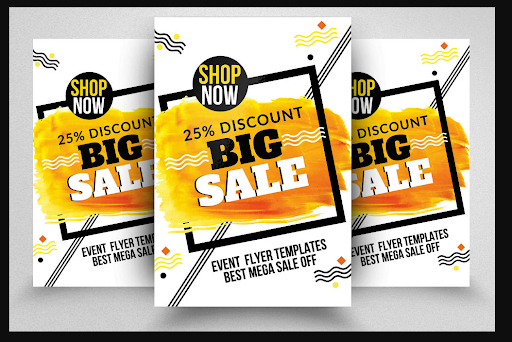
An example of a leaflet design by Thehungryjpeg. Source: Thehungryjpeg
6. Create a lasting impression
If you provide something worth keeping, you can significantly enhance the impact and success of your campaign.
Physical items are a lasting reminder of your brand. They keep you front-of-mind and reinforce brand recall, even after the initial interaction. As well as promotional items, gifts and keepsakes, direct mail that continues adding value includes calendars, cool postcards, menus, membership/promotional cards, directories, high-quality brochures, newsletters, etc.
Furthermore, if the item is useful or interesting, recipients may share it with others, leading to word-of-mouth marketing and extending the reach of your campaign.
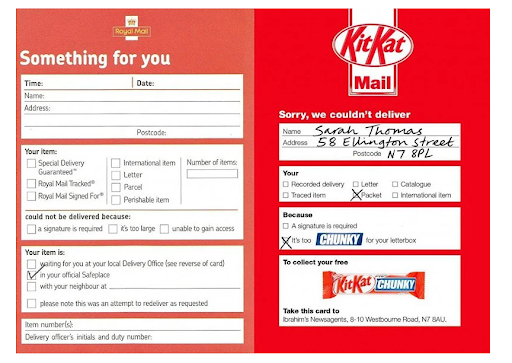
A few years ago, Nestlé® made waves with a brilliant direct mail campaign that continues to captivate audiences today. They cleverly sent out mailers designed to look like the missed delivery postcard by Royal Mail. Image source: Penji
7. Include clear call-to-actions
Whatever your objective, you must add a clear call-to-action (CTA) to your marketing collateral. An essential and pivotal element in any direct mail campaign, a CTA tells recipients what to do next – whether that’s making a purchase, signing up for a newsletter, visiting a website, or calling for more information.
When planning an impactful direct mail campaign, one of the first steps is deciding what you want the recipients to do. Armed with this information, you must ensure that your direct mail succinctly communicates the desired action without any confusion.
A clear CTA also allows for easy analysis of the campaign’s execution. You can track your CTA’s performance and use this insight to evaluate the campaign’s success and inform future strategies.
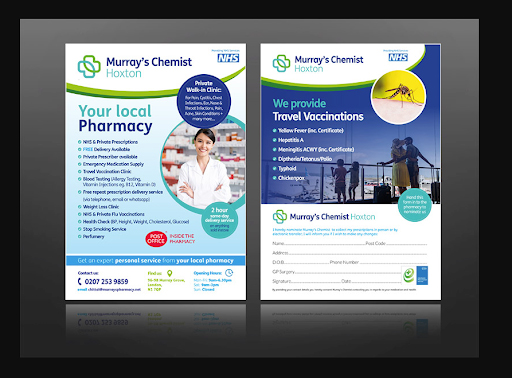
An example of a pharmacy leaflet with call to actions by Stuart Hodgson. Source: Stuart Hodgson
8. Include tracking links
You can use tracking to connect any form of engagement – be that via phone, text, website, etc- back to the advertising source. And by implementing tracking mechanisms into your direct mail, you can effectively measure the success of your campaign.
With tracking information, you will also gain insights into what worked and what didn’t, and you can use this understanding to optimise and improve future campaigns.
![]()
An example of a leaflet with a QR code and telephone number by Prestigeprint. Source: Prestigeprint
How much does direct mail marketing cost?
Direct mail can be highly cost-effective when compared to online marketing. It also offers impressive engagement rates and ROI. As such, direct mail is a compelling option for businesses. Also, if you use data to inform your direct mail campaigns, you can boost your ROI even further by spending your money where it is likely to deliver the best results.
Prices will vary by campaign and are typically influenced by a range of factors including mailing size, printing costs, fulfillment costs and obtaining any GDPR compliant mailing lists.. At Blue Market Media, we can advise you on price and offer some simple ways to make the process more cost-effective.
Is direct mail still effective?
Yes! By delivering tangible marketing materials directly to your target audience and providing a uniquely physical marketing experience, direct mail continues to capture attention, engage potential customers, and boost sales. But you don’t have to take our word for it.
- In Q1 2023, a whopping 95% of mail was engaged with and had some form of physical interaction from consumers. {JICMAIL}
- Over the same period, 30% of mail prompted commercial actions from consumers such as purchases, voucher redemption, website visits and store footfall. {JICMAIL}
- 79% of consumers will act on direct mail immediately, compared to only 45% who say they deal with emails immediately. {Direct Marketing Association}
- 90% of campaigns that included physical mail saw an increase in new customers, compared to 59% of those without. {Royal Mail Group}
- On average, advertising mail delivers £14 ROI for every £1 spent. {PostGrid}
- 50% of consumers 35+ say that direct mail feels more important than email communication from a brand. {Lob}
- 57% of millennials act on direct mail offers. {UPS}
- 72% of Gen Z look forward to discovering mail with excitement. {UPS}
- Integrated campaigns that included door drops achieved +18% more frequency, and +7% more reach {Royal Mail Group}
- The proportion of direct mail that is driving web visits is growing 50% year-on-year {DMA}.
Conclusion
Direct mail is one of the best-kept secrets in marketing. And today, businesses of all shapes and sizes are waking up to using it as part of their broader marketing efforts. However, the effectiveness of direct mail depends on a variety of factors. You must consider content, format, targeting, design, print, data, technology, and more to maximise spending and ensure an impactful campaign.
If this sounds overwhelming, contact Blue Market Media today. An expert direct mail agency, we have everything it takes to deliver results for your business. Simply call our office today on 020 3538 9753 or complete our online enquiry form.
